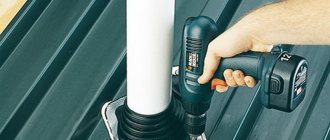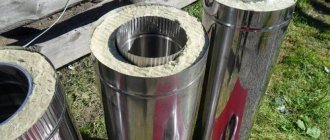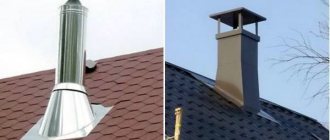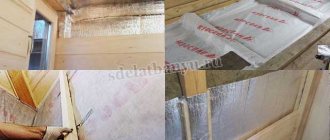Mechanism of operation
A metal stove placed in a house, garage or bathhouse must be equipped with a chimney to remove carbon monoxide and organize draft. During the process of heating the furnace, this pipe can reach very high temperatures, about 200-500 ℃, which is unsafe for people in the room.
If you install a heat exchanger on the chimney, you can significantly increase the efficiency of the stove, and also protect yourself from direct contact with a hot surface. In a tank or coil installed on the chimney, the coolant will be water, however, you can also install an air heat exchanger on the chimney pipe. Due to the direct contact of the chimney with the coolant, their temperature indicators are balanced, that is, the water or air gradually heats up, and the walls of the pipe cool down.
As the temperature of the water inside the register rises onto the pipe, it rises upward, where it enters the water tank through a special fitting. Through the inlet fitting located at the bottom of the heat exchanger, cold water enters it, replacing warm water. This circulation continues constantly, and the water can heat up to very high values.
An air radiator on a chimney pipe has a similar operating principle. Cold air enters the heat exchanger from below, and after heating it rises up and is supplied through the pipeline to the heated rooms. In addition, the radiator fins also give off heat. An air heat exchanger is optimal for heating attics in a country house or dressing rooms of a bathhouse, if such rooms are heated only from time to time. It is not advisable to organize water heating in them, since you will have to constantly fill and drain water from the system.
Choosing the right material
It is best to use a stainless steel heat exchanger. Even when exposed to high temperatures, the physical characteristics of the metal remain stable. This is why welds seem quite strong, and when exposed to oxygen they form a protective film. It withstands acidic environments. Speaking about the use of zinc, when temperatures reach 200 degrees, it evaporates.
At 500 degrees, the vapor content in the air reaches critical levels. At the same time, if there is galvanization, there is no need to worry. True, the maximum temperature should not reach above 200 degrees. Galvanized material can be used, as it promotes enhanced mixing of air flowing around the device. This kind of heat exchanger is not suitable for constant maintenance, but to warm an attic or bathhouse, this is the best option.
This element can be installed easily and simply. It can be installed on a simple potbelly stove; its façade is faced with brick, just like the stove itself.
This is interesting: wood-burning cast iron stoves for summer cottages.
Instructions for making a tank
Often in stores you can buy a heat exchanger for a heating pipe with an already made water circuit. All that remains is to mount it on the new factory stove and you can use it. However, if you wish, you can make a heat exchanger for the chimney pipe with your own hands.
The following materials will be required:
- sheets of steel and pieces of stainless steel pipes of different sections with walls 1.5-2 mm thick;
- 1″ or 3/4″ fittings to connect the water circuit to the heating system;
- large water tank made of galvanized or stainless steel with a volume of 50-100 liters;
- flexible hoses or pipes made of copper or steel for hot water;
- tap for draining water from the system.
Work on assembling a heat exchanger with a tank consists of the following steps:
- Drawing development. Based on the type of stove and the diameter of the chimney, the dimensions of the tank are determined. In simple metal stoves with a direct chimney at the outlet, the gases are very hot, so the heat exchanger can be quite large - about 50 cm high.
- The inner diameter of the walls of the storage tank must be selected so that it fits tightly onto the chimney pipe. The outer diameter of the tank should be 1.5-2.5 times larger than the internal cross-section. Such parameters allow you to quickly heat the coolant and ensure its free circulation. If the gases coming out of the furnace are not very hot, then it is better to install a heat exchanger on the chimney pipe for heating of smaller sizes, so that condensation does not accumulate and there is good draft.
- You need to use a welding machine to fasten all the structural elements together, making sure that the seams are airtight. Fittings for water circulation are welded at the top and bottom of the tank.
- The water boiler is seated very tightly on the smoke fitting, additionally treating the seams with heat-resistant sealant. In the upper part of the tank, an adapter is attached in the same way to an insulated pipe, which is led outside through the ceiling or wall.
- The heating circuit with coolant is connected to the storage tank. The incoming pipe with cold water is led through a fitting to the tank with an inclination of 1-2 degrees. The hot water pipe, connected to the tank through the upper fitting, has an inclination of 30 degrees. In this case, the storage device itself is mounted above the heat exchanger.
- A tap is installed at the lowest point of the tank to drain the water. In the steam room it can be combined with a tap for drawing hot water.
- Before heating the stove, water is poured into the system so that the metal elements do not overheat and the seams do not burst.
- Filling the heat exchanger with water can be either manual or automatic. If you fill the water manually, you need to install a transparent tube on the outer wall to monitor the water level.
It is worth noting that the distance from the circuit to the tank should not be more than 3 meters, and it is better to take the pipe diameter no narrower than 3/4″.
How the device works
What does a pipe-in-pipe heat exchanger consist of? It’s not hard to guess: from a pair of pipes mounted one inside the other (scientifically, coaxially located). The coolant moves through each of the elements. The “device” can be adjusted by correctly selecting the diameter of the elements. The design is so simple that any owner with a little time and desire can make a pipe-in-pipe heat exchanger with his own hands.
This is what a heat exchanger for a water supply looks like
Features of the functioning of the device
The described devices are used for cooling or heating coolant for relatively moderate heat exchange surfaces - about 50 square meters. If you make a special calculation of a pipe-in-pipe heat exchanger, you can even achieve boiling or even condensation of the coolant.
Also, if necessary, the heat exchange area can actually be increased, but additional sections will have to be built.
In order for surface cleaning to be carried out with the same quality in any part of the structure, on both sides, it is important to correctly select and skillfully connect the outlet/inlet pipes. Then the unit will work efficiently, evenly distributing flows across each channel
This point is especially important for installing cooling devices when the temperature drop is unacceptable.
The principle of operation of the “device” is extremely simple: a pair of coolants are separated from each other by a partition through which heat exchange takes place. The side-by-side arrangement allows for a relatively compact structure. The distribution of processes inside the device occurs as follows: saturated steam is concentrated between the pipes, and the liquid moves through the inner pipe.
The price of the described device is not low, but its mission, you see, is important. The design of a pipe-in-pipe heat exchanger can vary, based on different layout options. However, any of the invented types of units can be assembled by good craftsmen right on the spot, using standard elements and relying on a drawing.
1 – heat exchange pipe; 2 – shell pipe; 3 – support; 4 – grid of casing pipes; 5 – camera
Scope of application of devices
This type of heat exchanger is used in many areas - both in the industrial segment and in the domestic area. Gas production and transportation, oil supply and purification, sedimentation water treatment, movement of chemical compounds - all these processes become possible thanks to the use of pipe-in-pipe structures. This type of heat exchanger is also widely used in public utilities - to supply hot water to the population, plants, factories and other buildings. If you make a special calculation of a pipe-in-pipe heat exchanger, then such a design can even be used in thermal power engineering. One of the most interesting applications of the “hero” of the article is the production of wine and dairy products. Even in the food industry one cannot do without heat exchangers.
Device diagram
Heat exchanger in the form of a coil
If the installation of the previous type of heating from a chimney pipe requires the ability to operate a welding machine, then the design of a heat exchanger in the form of a coil is much simpler. You just need to wrap a few rings of flexible aluminum or copper pipe around the chimney. These metals have a high level of thermal conductivity and are not destroyed due to corrosion.
The diameter of the tube should be convenient for connecting to the fitting of the storage tank. It is optimal to choose a pipe with a cross-section of no more than 28 mm for bending. The length of such a circuit should not exceed 3 meters in order for the water circulation to be correct. Using a flexible connection, you can connect the tank to the coil.
As a rule, coils are used to heat water, although sometimes for heating small rooms. Coils mounted on the chimneys of a metal furnace with a very high temperature of carbon monoxide perform best.
Power calculations
All calculations will always be approximate; in each individual case it is difficult to determine the power that will be required to heat a room, steam room, etc.
It is generally accepted that no more than 5 kW is enough to heat an ordinary bathhouse. For example, 1 sq. m of heat exchanger (its area) is equal to 9 kW of the furnace. Keep in mind that the power will be significantly reduced after the furnace or boiler goes out, so the calculation must be made based on the surface of the furnace heat exchanger. Therefore, when calculating, try to take into account the maximum area of the heat exchanger to ensure sufficient temperature even with a one-time fire.
The shape in this case practically does not matter; it can be as different as you like. A register made of stainless steel pipes is considered the most optimal, but gradually its place is taken by a welded manifold made of two channels. A heat sink of this shape is considered less easily produced, but it does not require a lot of material for its installation and installation.
Also, do not forget to take into account the type of chimney itself; it is quite difficult to install a high-quality heat exchanger on brick chimneys, unlike metal ducts. Therefore, when giving preference to independent work, proceed from convenience.
Coil installation method
You can install a coil heat exchanger on the chimney of a sauna stove or potbelly stove in a garage or shed. It will serve for heating or for heating water.
To work you will need:
- aluminum or copper tube up to 3 m long;
- 2 3/4″ fittings and a flexible hose for hot water;
- boiler with a float valve for filling with water and a valve for its use;
- tap for draining coolant from the system.
The system installation technology looks like this:
- The first step is to bend the tube so that its cross-section remains unchanged. For copper pipes less than 28mm in diameter, you can use a pipe bender without heating them. But steel, aluminum and products with large diameters require preheating with a blowtorch.
- For bending, you can use dry sand, filling the pipe with it and closing it with plugs on both sides. A spiral bend is made according to the sample, after which sand is poured in and the pipe is washed under water pressure.
- At the end parts of the tube, threads are cut for adapters for fittings, and then connected to the system.
- The resulting coil is mounted on the chimney. If you solder it with tin to the pipe, the heat transfer will be better. Preliminary degreasing is carried out with orthophosphoric acid.
- A storage tank is hung on a support or on the wall a little above the coil. Connect it to the heat exchanger with a flexible connection and install a tap at the bottom of the tank.
Note that for safe and long-term use of a heating coil, you need to install a pump that circulates water in the system and prevents overheating.
Options for connecting structures
The heat exchanger on the chimney can operate in two main modes. And each of them has its own process of heat transfer from smoke to the inner pipe of the heat exchanger.
So, in the first mode, we connect a remote tank with cold water to the heat exchanger. Then water condenses on the inner pipe, causing the heat exchanger itself to heat up solely due to the heat of condensation of water vapor from the flue gases. In this case, the temperature on the pipe wall will not exceed 100°C. And the water in the tank will take a long time to heat up.
In the second mode, condensation of water vapor on the inner wall of the heat exchanger does not occur. Here the heat flow through the pipe is more significant, and the water heats up quickly. To more fully understand this process, conduct this experiment: place a pan of cold water on a gas burner. It will be clearly visible how condensation will appear on the walls of the pan and it will begin to drip onto the stove. And despite the flame being 100°C, this state will continue for a long time until the water in the pan itself warms up. Therefore, if you use a heat exchanger on a pipe as a register for heating water, then give preference to small designs with thick walls of the inner pipe - this way there will be much less condensation.
Pipe on tin - simple and durable!
This option is simple, practical and convenient. In fact, here the chimney is simply wrapped around a metal or copper pipe, it is constantly heated, and the air distilled through it quickly becomes warm.
You can weld the spiral to your chimney using an argon torch or semi-automatic welding. You can also solder with tin - if only you degrease it with phosphoric acid in advance. The heat exchanger will hold on to it especially tightly - after all, samovars are soldered with tin and last a really long time.
Corrugation - cheap and cheerful
This is the simplest and lowest-budget option. We take three aluminum corrugations and wrap them around the chimney in the attic or second floor. The air will be heated in the pipes from the chimney walls, and it can be redirected to any other room. Even a fairly large room will be heated to hot temperatures while you heat the steam room stove. To make heat removal more efficient, wrap the corrugated spirals with regular food foil.
Heat exchanger-hood - for warming up the attic
Also, in the chimney section in the attic room, you can install a heat exchanger that would work on the principle of a bell-type stove - this is when hot air rises up, and cools down slowly. This design has its own huge advantage - an ordinary metal chimney on the second floor usually becomes so hot that it cannot be touched, and such a heat exchanger will significantly reduce the risk of fire or accidental burns.
Some craftsmen also cover such heat exchangers with a mesh with stones to accumulate heat and decorate the heat exchanger stand. In this case, the attic becomes even more comfortable and can be used as a living space. After all, based on practice, the temperature of the sauna stove pipe does not exceed 160-170 °C if there is a heat exchanger on it. And the highest temperature will already be located only in the gate area. Warm and safe!
List of sources
- gidpopechkam.ru
- kaminguru.com
- econet.ru
- ZnatokTepla.ru
- stroy-banya.com
- sovet-ingenera.com
- banyaspec.com
- trubsovet.ru
- Author: Sergey
Share with your friends!
Negative points
Along with the benefits of a heat exchanger on a chimney, it is worth noting a number of negative factors. Firstly, due to this design, the temperature of the exhaust gases is significantly reduced. This can provoke excessive soot accumulation, condensation formation and poor traction.
An important point in arranging such a heating system is to calculate how much water is needed for its full functioning. If there is not enough of it, the system may overheat, the water in it will boil, and the pipes may burst. In addition, it is important to ensure the tightness of the seams.
In any case, installing a heat exchanger allows you to increase the efficiency of any furnace. For safety reasons, at least twice a year, visual diagnostics of the system and its maintenance should be carried out - cleaning soot, replacing defective elements, and so on. Then it will be possible to confidently use the heat exchanger for heating the house and heating water in the bathhouse.
Work specifics
Today, heat exchangers of various types are produced. In general, the features of their operation, as well as the design characteristics, are similar. The structural properties of such an element:
- Full body available.
- Presence of outlet and outlet pipes.
- Braking mechanism for combustion products. Its role is played by valves with cutouts that are installed on the axles.
The flaps can be turned. A zigzag chimney of varying lengths is formed. The valves can be adjusted to ensure the ratio of draft and heat transfer is as efficient as possible. Safety standards are met.
In this video you will learn how to make a heat exchanger:
Types of sauna tanks installed on a pipe
Today, there are several options that can make bathing procedures simpler and more convenient. Let’s say right away that you can install a water heater in the washing room and run cold water to it. However, there is no point in wasting electrical energy, because the bathhouse will still be heated in any case. To ensure that people who wash themselves are provided with hot water, you need to install a tank in which it will be heated.
There are several classifications of such tanks; let’s take a brief look at each of them. So, according to their location, tanks can be of three types.
Note! If you prefer the third option, then select a large tank, since the heating element can be used along its entire length. This reservoir can run along the chimney up to the ceiling, and in some cases even cover part of the attic space.
A lot depends on the material used in the production of the tank. This includes the time during which the water remains warm, the rate of heating itself, and even the service life of the container. Today, tanks are made from three main materials.
Finally, tanks are classified according to their volume. There is an opinion that 10 liters of heated water is enough to wash one visitor in a bathhouse. And to calculate how much tank volume you need, you need to take the total number of people who will be steaming and multiply it by 10. As a result, you can find out the required volume.
However, there are several factors to consider.
- If the power of the heating device is low and the area of the steam room is large, the water will not have time to warm up properly.
- And if the tank is too small, it will quickly evaporate.
In other words, when choosing the required volume, you must take into account all aspects and choose the option that satisfies all the conditions.
Chimney pipes for baths
Modern versions of the bathhouse are equipped with chimneys for economic reasons - soot quickly destroys finishing materials, and to meet fire safety requirements. Of the chimney pipes existing today, only a few are used, as increased demands are placed on them.
- Brick - the material is fireproof, has excellent heat transfer, that is, it accelerates the heating of the room and maintains the temperature. However, it is quite difficult to install and requires periodic cleaning. This option excludes the installation of a water heater on a pipe; only remote modifications can be used.
- Ceramic - resistant to high temperatures, durable, but has a significant cost.
- Asbestos - unsuitable for chimneys in a bathhouse, as they do not tolerate temperature changes well.
- Metal - products made of ferrous metal are not recommended, since under the required operating conditions they quickly burn out and are also heavy. A stainless steel product is much more resistant to temperature changes and has a very attractive price. Today this is the most popular option.
The metal has low thermal conductivity, meaning it heats up quickly and does not retain heat. But it is precisely this property that can be used to quickly heat water, thereby reducing costs.
How to make a homemade convector for a chimney to heat air? (+detailed video)
To create the simplest convector that will improve air heating in the same room where the boiler is located, you will need:
- Welding machine.
- At least 8-10 thin steel tubes with a diameter of about 32 mm and a length of about 50-60 cm. Ideally, take food-grade stainless steel. Worse, but also suitable, is galvanized steel. In shape - they usually take round tubes, but square or rectangular ones are also suitable.
Installation is carried out as follows: you need to weld these tubes in a circle around the chimney, as close as possible to the firebox.
Review of Furanflex polymer chimneys: characteristics, pros and cons
Rules and methods for lining a chimney: comparison and step-by-step work











